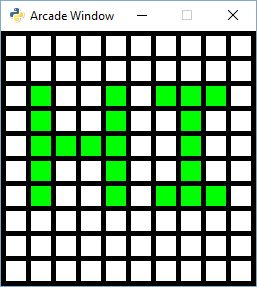使用精灵v2的栅格#

您可能还需要查看以下内容:
阵列支持的网格 -速度很慢但很简单,使用绘图命令
阵列支持的网格已缓冲 -速度较慢,并使用缓冲形状
使用精灵v1的栅格 -超快,并使用精灵。在一次函数调用中重新同步到编号网格
使用精灵v2的栅格 +(这个程序)超快,使用精灵。保留第二个精灵2D网格以匹配2D数字网格
array_backed_grid_sprites.py#
1 2 3 4 5 6 7 8 9 10 11 12 13 14 15 16 17 18 19 20 21 22 23 24 25 26 27 28 29 30 31 32 33 34 35 36 37 38 39 40 41 42 43 44 45 46 47 48 49 50 51 52 53 54 55 56 57 58 59 60 61 62 63 64 65 66 67 68 69 70 71 72 73 74 75 76 77 78 79 80 81 82 83 84 85 86 87 88 89 90 91 92 93 94 95 96 97 98 99 100 101 102 103 104 105 106 107 108 109 | """ Array Backed Grid Shown By Sprites Show how to use a two-dimensional list/array to back the display of a grid on-screen. This version makes a grid of sprites instead of numbers. Instead of interating all the cells when the grid changes we simply just swap the color of the selected sprite. This means this version can handle very large grids and still have the same performance. If Python and Arcade are installed, this example can be run from the command line with: python -m arcade.examples.array_backed_grid_sprites_2 """ import arcade # Set how many rows and columns we will have ROW_COUNT = 15 COLUMN_COUNT = 15 # This sets the WIDTH and HEIGHT of each grid location WIDTH = 30 HEIGHT = 30 # This sets the margin between each cell # and on the edges of the screen. MARGIN = 5 # Do the math to figure out our screen dimensions SCREEN_WIDTH = (WIDTH + MARGIN) * COLUMN_COUNT + MARGIN SCREEN_HEIGHT = (HEIGHT + MARGIN) * ROW_COUNT + MARGIN SCREEN_TITLE = "Array Backed Grid Buffered Example" class MyGame(arcade.Window): """ Main application class. """ def __init__(self, width, height, title): """ Set up the application. """ super().__init__(width, height, title) # Set the background color of the window self.background_color = arcade.color.BLACK # One dimensional list of all sprites in the two-dimensional sprite list self.grid_sprite_list = arcade.SpriteList() # This will be a two-dimensional grid of sprites to mirror the two # dimensional grid of numbers. This points to the SAME sprites that are # in grid_sprite_list, just in a 2d manner. self.grid_sprites = [] # Create a list of solid-color sprites to represent each grid location for row in range(ROW_COUNT): self.grid_sprites.append([]) for column in range(COLUMN_COUNT): x = column * (WIDTH + MARGIN) + (WIDTH / 2 + MARGIN) y = row * (HEIGHT + MARGIN) + (HEIGHT / 2 + MARGIN) sprite = arcade.SpriteSolidColor(WIDTH, HEIGHT, arcade.color.WHITE) sprite.center_x = x sprite.center_y = y self.grid_sprite_list.append(sprite) self.grid_sprites[row].append(sprite) def on_draw(self): """ Render the screen. """ # We should always start by clearing the window pixels self.clear() # Batch draw the grid sprites self.grid_sprite_list.draw() def on_mouse_press(self, x, y, button, modifiers): """ Called when the user presses a mouse button. """ # Convert the clicked mouse position into grid coordinates column = int(x // (WIDTH + MARGIN)) row = int(y // (HEIGHT + MARGIN)) print(f"Click coordinates: ({x}, {y}). Grid coordinates: ({row}, {column})") # Make sure we are on-grid. It is possible to click in the upper right # corner in the margin and go to a grid location that doesn't exist if row >= ROW_COUNT or column >= COLUMN_COUNT: # Simply return from this method since nothing needs updating return # Flip the color of the sprite if self.grid_sprites[row][column].color == arcade.color.WHITE: self.grid_sprites[row][column].color = arcade.color.GREEN else: self.grid_sprites[row][column].color = arcade.color.WHITE def main(): MyGame(SCREEN_WIDTH, SCREEN_HEIGHT, SCREEN_TITLE) arcade.run() if __name__ == "__main__": main() |